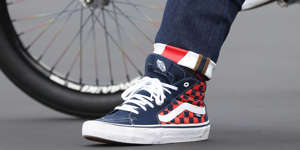North Face makes up for weak demand for Vans in VF Corp.’s results, and shares rally
North Face #NorthFace


EARNINGS RESULTS
Shares of VF Corp. rose after hours on Tuesday after the footwear and clothing maker reported fourth-quarter results that were better than expected, as stronger demand for company’s North Face gear offset weaker trends for Vans shoes.
The company reported a fourth-quarter net loss of $214.9 million, or 55 cents a share, contrasting with a profit of $80.8 million, or 21 cents a share, in the same quarter last year. Sales fell to $2.74 billion, compared with $2.8 billion in the prior-year quarter.
Adjusted for impairments and a pension settlement charge, VF earned 17 cents a share. Analysts polled by FactSet expected adjusted earnings of 14 cents a share, on revenue of $2.72 billion.
Vans sales fell 14% during the quarter, but sales at outdoor-wear maker The North Face were up 12%.
Management said it expects sales for the year ahead to be “flat to up slightly in constant dollars.” But they said they expected a “high-single-digits” dip for those sales in the first quarter, reflecting “a challenging U.S. wholesale environment” where retailers have been more cautious about ordering lower-demand items like clothing and accessories.
The company forecast earnings per share of $2.05 to $2.25. FactSet forecast adjusted earnings of $2.16 a share.
“FY24 will be a year of progress as initiatives underway begin to drive results,” Chief Financial Officer Matt Puckett said in a statement. “We will be laser-focused on execution amidst an increasingly difficult near-term environment, particularly in U.S. wholesale.”
Shares rose 2.8% after hours on Tuesday.
The company also declared a quarterly dividend of 30 cents a share.
Wedbush analysts, in a research note on Monday, said that discounts have proliferated among the Vans sneakers being sold at retailers. The brand has faced competition from casual offerings from Adidas and a more subdued environment, as higher-priced groceries and other basics siphon away consumer dollars that would be spent on other goods.